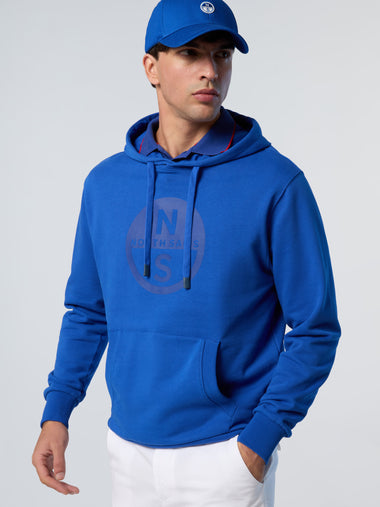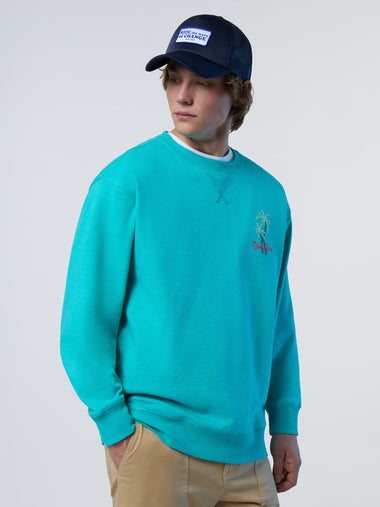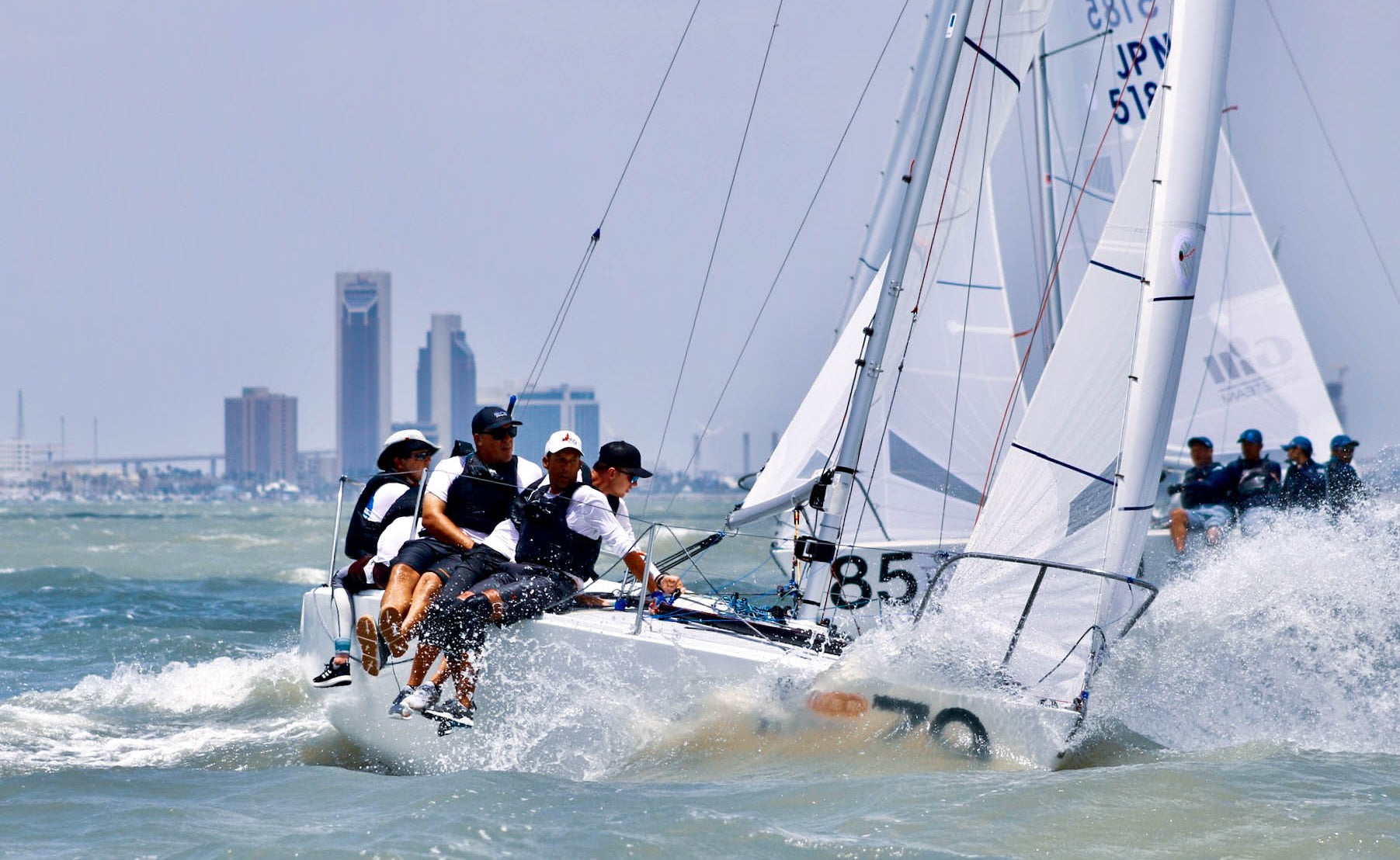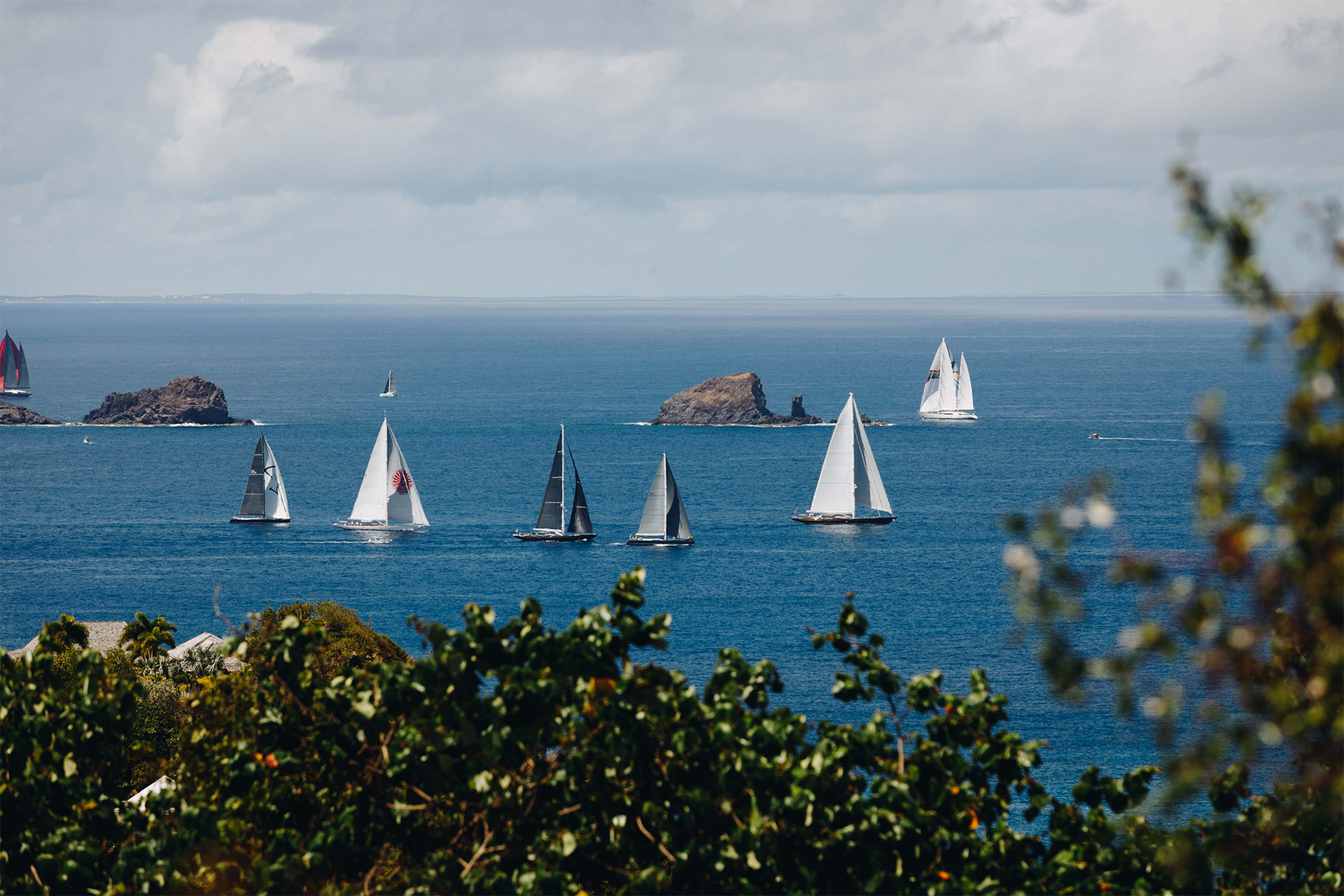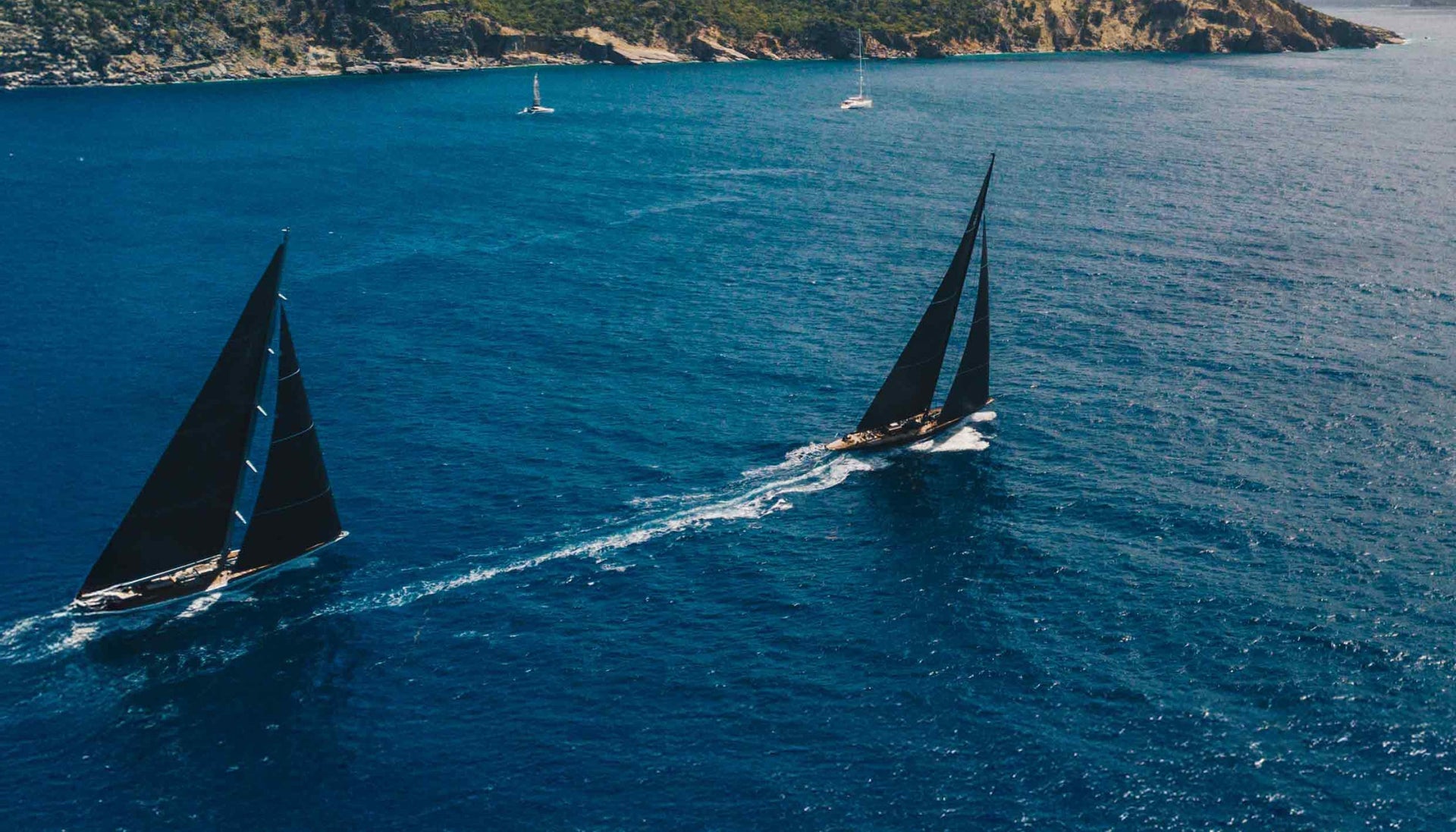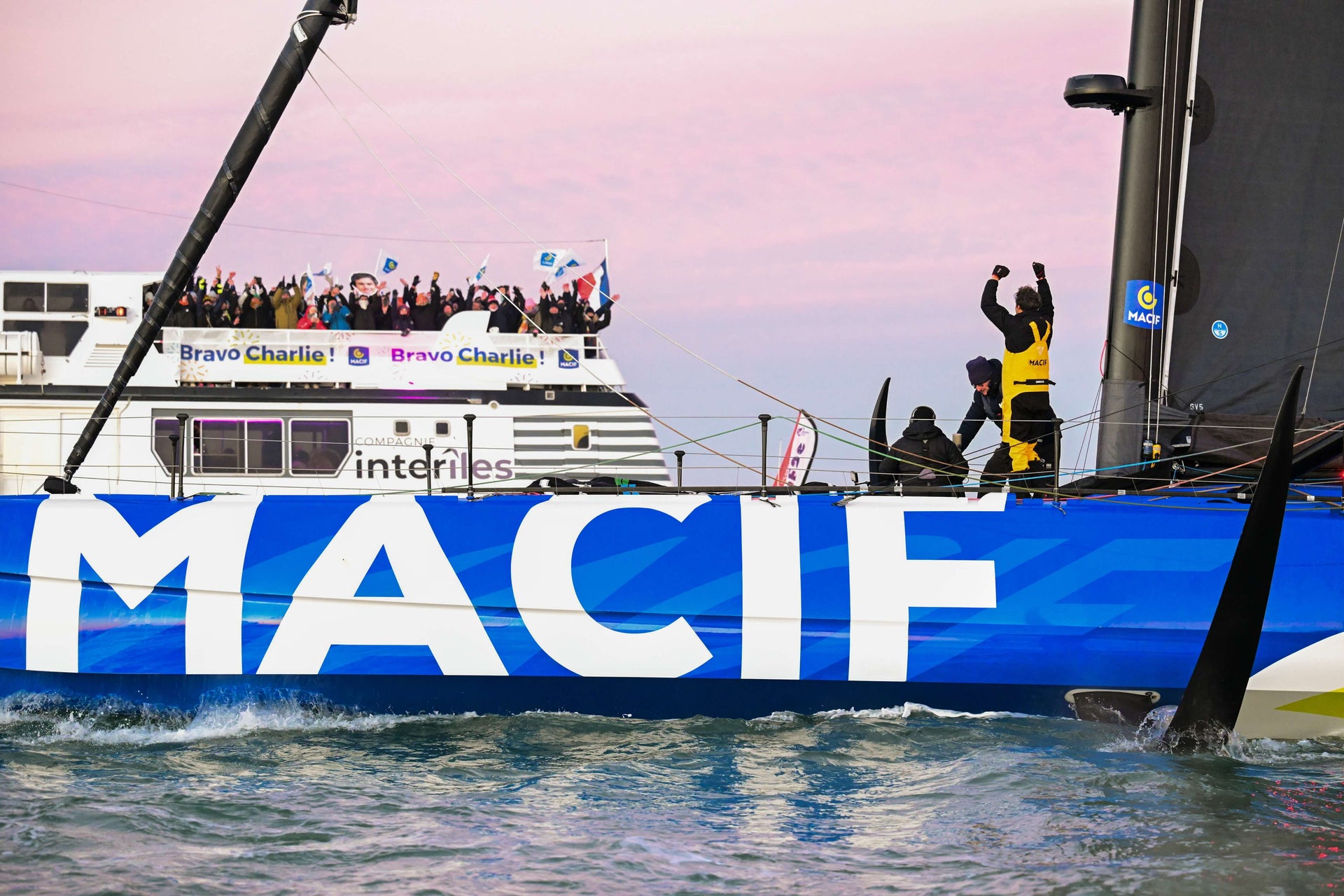MIKEY AND THE GARAGE ROCKET
MIKEY AND THE GARAGE ROCKET
North Sails Experts Claim 2022 J24 World Championship

There are plenty of clichés in sailboat racing, and perhaps one of the best is, “you’re only as good as your last race.” And what exactly does this mean? We’ll get to the answer eventually, but let’s begin our story with Mike Marshall and his teammates on American Garage—trimmer David Hughes, tactician Allan Terhune, pit Jeff Hayden and bowman Rod Favela—as they are pacing near the signal boat at the J/24 World Championships in Corpus Christi, Texas, having been dinged with a black flag on the fourth and critical penultimate day of racing.
“It was self-inflicted,” Terhune says. “We didn’t manage our time and distance appropriately, plain and simple. We had a bit of pep in our step, we were still fourth
The mistake was nerves, the energy of the day, Marshall says. They set up too close and too early near the pin end of the starting line. “We didn’t need the risk,” he says, “and we would have been happy without it.”
Lesser teams would have caved and thrown in the towel, but the opposite happened onboard American Garage. “Sailing back and forth for an hour and half waiting for every boat to finish, you might start thinking, ‘That’s it,’ but we said we can either pack it up now or just keep fighting. Part of that fight was that we knew we had to step on the gas, and that’s where our second in the next race came from.”
Later that night, Marshall and his teammates rallied around the scoresheet, and the path forward was clear. “It was obvious that our results were improving in the back half of the regatta,” he says. “The numbers were saying that—mathematically—our results were getting better while others were not. We all agreed going into the last day that this was ours to give away.”
They were confident—not cocky—Terhune says, because they knew they were hitting their stride. They had the right team and the right boat to get ‘er done. Which brings us to the boat, No. 3379, and its part in this incredible story. The boat has always been called American Garage as far as Marshall knows. It’s a 1982 vintage J/24 once co-campaigned by Soling Olympic Silver medalist Kevin Mahaney and Hall of Famer Dave Curtis. At some point, American Garage was put out to pasture on Cape Cod until it was discovered by North Sails’ Will Welles, himself a J/24 world champion.

Welles knew Marshall had been looking for a boat capable of winning the J/24 worlds, so he paid the owner a visit. “We went out and looked at it and it was a total disaster,” Marshall says. “It had been sitting under a tarp that was less of a tarp and more of a rain catcher.”
The boat sat in Marshall’s yard, continuing to rot from the inside out while he contemplated what to do with it and whether he was willing to undergo and underwrite such an extensive refit. What soon followed was not a project born of boredom, but of motivation and calculation.
The dilapidated vessel was towed to Chris and Monica Morgan’s speed shop in Florida with the goal of a six-month turnaround, which, of course, became a year and six months. “The only reason it happened was because of Chris and Monica,” Marshall says. “They did an amazing job on the boat and they worked hard to get it done.”
The Morgans, masters of the longboard, replaced 70 percent of the deck and gutted the interior. “The only thing we didn’t do was change the keel,” Marshall says. “The hull, keel and rudder were media blasted, faired, and repainted. We put on new hardware, got a newer mast and all new lines. What was essentially left of the original American Garage was the hull, so it seemed fitting to keep the name.”
Why go through such effort when a professional sail designer of his stature could have a much newer boat at his disposal? “I don’t know,” he says. “There are fast boats and there are some boats that are just never there. But at the end of the day, a boat that can win the J/24 Worlds is a no-excuses boat.”
Marshall knew American Garage was fast back in its day, and clearly it still is today.
“We sailed the whole event at the top of the genoa, and didn’t break anything,” he says. “Even when we were on the wrong side of the racecourse the boat was doing the work and still going fast. It comes down to all the little things adding up to one-tenth of a gain here and there. If it gives you a half boatlength at the first windward mark, that’s a huge deal.”
When it comes to J/24s, having the right keel shape is important, he adds, as is a good mast and the right sails, but “having a boat that you didn’t lose anything because it didn’t break is 80 percent of it and having a boat that has all the boxes checked—it’s stiff, it’s fair, the keel is right, the rudder is right and everything is correct.”
But we all know it’s not that simple. Fixing an old boat is half the battle. They still have to get the most from it in all conditions. Enter Dave Hughes, the three-time Olympic 470 sailor who brings to the program a level of detail bordering on obsessive-compulsive. “He was a big pusher of writing things down, which we all do, but he does it to the extreme,” Marshall says.
As they became students of the boat in the months and miles leading up to the 2022 worlds, Hughes applied the meticulous processes required of an Olympic campaign.

“It wasn’t until Midwinters this year, in very light air, where we saw we were lacking a bit of power and started to mess around and write our settings down in anger,” Marshall says. “At that event, we began putting our mast-butt settings together. The tuning guide for the newer masts is basic rig tuning, so we had those settings from day one, so it was really about locking in the mast-butt locations for the boat and what the boat wanted in each condition. That’s been ongoing and it continued a lot during Worlds.”
Terhune, who’s sailed with a lot of top programs in his decades as a professional sailor, was awestruck by Hughes’ obsession with measurements. “I’ve never seen two people work so hard to set up a boat so perfectly as Mike and Dave did,” Terhune says. “We made it a goal to be faster every day and we were. At Worlds, we had a good early part of the regatta, but I guarantee that the Day 5 American Garage team would have kicked the crap out of Day 1 team and that’s because Mike and Dave never stopped with the rig-tune development. I’ve never seen anyone write more things on a boat than Dave. It was a no-stone-unturned mentality and the level of detail they had was staggering.”
At the end of each sailing day, Marshall and Hughes would transfer all the scribblings to a Google Sheet for the team to review, keeping track of fast and slow settings. “We equally kept track of the things that were good and bad,” Terhune says. “That was part of the process that Dave was insistent upon, making sure we didn’t just talk about the rainbows.”
Even for Marshall, hyper-analytical himself, Hughes’ approach was next-level. “It was about getting rid of just changing the mast butt because it feels right, to having the data, having the measurement for the wind condition; getting rid of going by fingers on the headstay and actually having millimeter measurements. It was about documenting the good and the bad, but also how to move forward constructively from the bad stuff and then having it written and not guessing anymore. For example, before a race we’d say, “we want to go to 112 on the mast butt, we want to go plus-one, plus-two on the shrouds, and because we’re moving from 116 to 112 we need to add another half turn on the lowers. By looking at the wind conditions we know what it was—every time.”
That’s the unlocking speed of right there, and as Terhune noted earlier, they were getting more out of American Garage every day, and the faster they got, the more confident they grew.
On the opening day of the championship, Paul Foerster—Olympian, Hall of Famer, and one of the all-time greats of American sailing—and his team came out swinging on the same waters on which he won his J/22 World Championship title a year earlier, winning both races—by a Texan mile. The pecking order was established immediately. “We were all taken aback by how badly Paul crushed everyone.” Terhune says. “It was a thorough butt kicking, and everyone was scrambling after the first day.”
It was also a wakeup call for Marshall and Co. on American Garage. In any other championship an 8-2 in a stacked 38-boat fleet would be a good start, but with Foerster on fire, good wasn’t going to be good enough.

“That
The following day, the Corpus Christi wind machine turned on big time. Out came the blades, and these were not your normal blade conditions. It was, as Marshall says, easing-the-blade sailing: “Usually, when you step down from the genoa, you put the blade on and trim the thing in because it’s right at the crossover of the genoa. But this was blade-eased 6 to 12 inches kind of thing. It was at times so windy that we were just sailing off the leeches of both sails, where you step away from trying to sail fast with sails trimmed hard to trying to keep the boat flat and moving fast through the waves.”
Foerster continued his streak, starting the second day with another race win, but American Garage finally posted one of their own. On the scoreboard they were fourth, but they were finding their groove. “We had good pace, but knew we had more to go,” Marshall says. “It was a big one for us when we won that race and Paul did not.”
The following day, again with the blades, they won the first race and sailed home with a fifth. Everything was going in the right direction: “Another good set of scores kind of showed that Paul was beatable at that point,” Marshall says. “He was not going to run away with it and our job was to continue to chip away at the points and let the regatta come to us.”
The improvements and speed gains were happening live, both upwind and downwind. They were changing for the conditions, adapting on the fly. In the steep waves kicked up by consecutive days of 20- to 30-knot winds, starboard tack was straight into the milky blue walls. Port tack presented its own challenges. Marshall explains in detail with some good lessons for J/24 sailors: “Starboard tack was all about putting the bow down and keeping the boat moving. This is where I think people would give up a lot of height. I was doing it early in the regatta, trying to put the bow down to get the boat to accelerate, but I didn’t really need to because I was already at the right angle. I needed to let the boat do more of the work.
“Port was actually the harder one because as the wave rolled under us from the side it would roll the boat over and push it super heeled, but then as it went out from under the other side it would roll us back flat. Our initial thought there was that we didn’t need the power to get through the waves so we moved the jib car back a hole and didn’t think that was the right direction.

“On the third day, we moved the car forward to keep the upper leech of the jib engaged a bit more. As the wave rolls under the boat, the apparent wind on the jib changes massively because the boat is going sideways, and as it’s going down the other side of the wave, it’s going less sideways. So, keeping the cars forward to keep the upper leech a bit more engaged meant we weren’t giving away as much height on the backside of the waves. And I was super aggressive with the steering as the wave hit the bow to not let the wave push the bow downwind.”
By Day 3, their downwind sailing was improving too, says Terhune, thanks to Hughes’ dynamic trimming, and the sharp sail handling by the bow team of Hayden and Favela. “If there was one story of our regatta, it would be about the early part of the week we were very weak downwind—subpar even—and by the last day of the regatta we were probably one of the best boats downwind. That’s a function of Dave talking about what he felt on the sheets and the four of us talking about how to move around the boat. It took us a couple of days to get it right, and part of it was that we all changed our mentality of it being a J/24 where you just pull the pole back and go dead downwind.”
In a smaller fleet and on a smaller course you can kind of get way with sailing low and slow, Marshall says, but on a big course that’s not the case: “On a big course, where the leverage on each side is pretty unforgiving, you end up out on the edges and you have to be very quick on your side or you end up with big losses. The VMG has to be more important and that was our change—to not be too low and slow. That’s quite counter to what you would normally do on a J/24.”
It was all good on the morning of Day 4, but then came the black flag. But there would be no quit in this squad. They were only 3 points shy of the title with three races to go and they had to believe in the longer mission at hand. Their second-place finish that day kept them in the hunt.
“The
Back into genoa conditions, American Garage came alive, just as it had for Mehaney and Curtis back in its day. The squad led at the weather mark in the day’s first race and posted a third to Foerster’s second. With a bit of padding to those breathing down their necks, the final race was all about fleet management and letting the Garage do its thing. With no points to spare, those battling at the top of the fleet avoided direct skirmishes, leaving the team to sail its own race. In the first mark rounding they sailed right over the top of Foerster’s team as they struggled to get around the offset mark.
“I think, maybe, they were finally feeling the heat and knew we were not going to stop,” Terhune says. “They had their unforced error at the worst time. It’s still a mystery as to what happened. They got tangled up somehow, but it was the first break we got all week and it was the break we needed.”
And there is one key ingredient that can’t be ignored in this victory: “The sails we were using were the same as anyone else sailing with North Sails in the regatta,” Marshall says. “We’re not making ourselves a custom set of sails. Paul felt like he had a bit of an edge in speed with his other sails in light air, but eventually realized they were not all-purpose sails and they were a little off the pace at Nationals and pre-worlds. He initially had a cross-cut genoa, which is never going to be able to get through the full range. It might have an advantage in light air, but not in 18 knots.”
Foerster, Marshall says tried a lot of changes to get faster in breeze, but had limited results, so his solution was the ultimate grenade: a new mast and different set of sails, which dropped into his lap only days before Worlds. “He changed to North Sails and won the first three races, which is a good example that not all sails are built the same, and the crux of it is how you get that last 1/10 out of your boatspeed.”
The refinement of the American Garage’s inventory—the Newport Fathead Main and DDX7 Genoa (once called the Newport Genoa)—dates back to the early 1990s, the peak of the J/24 arms race. “Yes, there’s been updates and tweaks and finishing changes,” Marshall says, “but that main and the genoa combination remain the gold standard of J/24 sails.”
What makes them particularly fast, he adds, is their ability to be quick throughout the wind range. “It’s such a wide range and they’re so easy to set the boat up to be going 95 percent speed 95 percent of the time. That’s the key—if you want that extra two-tenths, you can work hard to get it like we did, but essentially, you can set the boat up with two fingers on the headstay in 15 knots and sail around at 27/24 and you’ll be happy with that all day long. Being able to go 95 percent speed 95 percent of the time without putting in too much effort is what wins regattas.”
American Garage now sits in Texas awaiting its next chapter, perhaps to never again be left to rot on Cape Cod, and onto the North Americans in Annapolis in October, where it will arrive, as the saying goes, as good as its last race.
Shop the Winning Inventory and Contact an Expert today.





